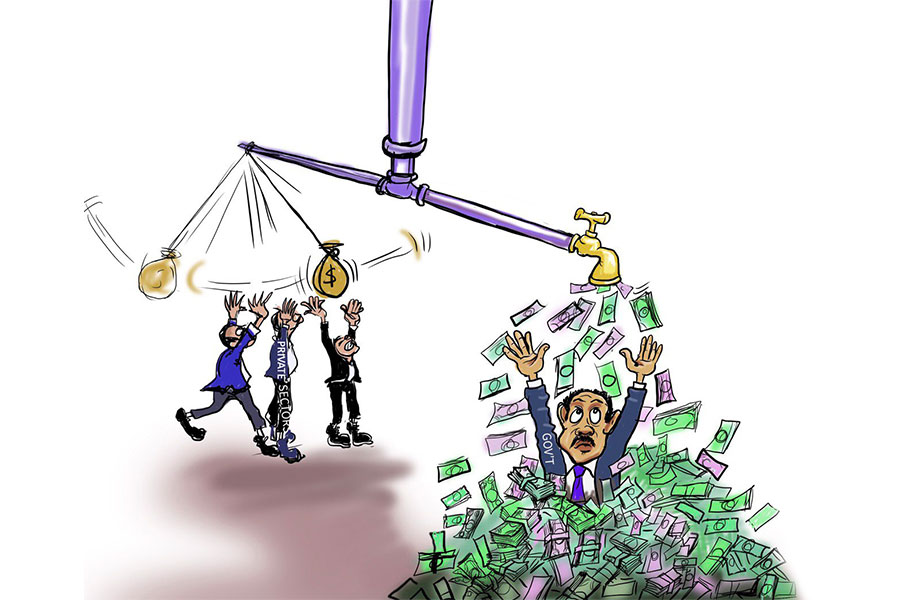
Radar | Sep 10,2023
May 25 , 2019.
If there is any Western country eager to help Ethiopia in the power sector, none match the enthusiasm and drive of the Danish government. Denmark, a country with an impressive record of 70pc reduction in its per kWh carbon emissions by switching to clean and renewable energy, is keen to explore alternative energy sources in this country.
A year ago, Denmark agreed to finance the construction of a new wind farm in Assela, 165Km south of the capital, to generate 100MW of power. Last week, a delegation of the Danish Energy Agency was here in Addis Abeba, and this week, Denmark sent a delegation to identify additional areas of cooperation in developing alternative sources of energy, as well as to promote management and skill sets in the field.
The Danish could not have arrived at a more auspicious time for the country. Just two weeks ago, Sileshi Bekele (PhD), minister of Water, Irrigation & Electricity, aroused the displeasure of the nation by announcing electricity rationing that took effect on May 9, 2019. Sileshi’s press statement to ration power to businesses and households is the final coup de gras for to a population that has been long suffering from steady power outages.
Initially, Sileshi announced that electricity would get cut off for five to six hours a day. Had there been a tradition of strong electoral accountability in the country, Sileshi would have been held accountable and subject to public fury and outrage. Here, where customers are accustomed to lacklustre services, citizens appear to have shrugged off the announcement.
Ethiopian Electric Utility, the state utility giant, changed the rationing schedule altogether last week, and power cuts are now scheduled in eight and nine-hour shifts. Some households actually reported outages that lasted 24 and 36 hours.
This, too, did not bring about the indignation of the public, for citizens have become too desensitised to the mismanagement and chaos of these state enterprises, who operate without accountability and transparency.
The almost-regular distribution failures of the transmission lines, ill-maintained equipment and inadequate maintenance regimes and constant power outages that customers are subject to are way beyond what Minister Sileshi is willing to admit. In an environment where undependable electric power supply persists, regular household chores become nearly impossible, business operations are negatively impacted and the manufacturing sector suffers.
The last time electricity was rationed was three years ago, following the El Nino-induced drought that hit much of East Africa. Although such a climatic condition did not affect the nation in the last rainy season - which has been described by the National Meteorology Agency as normal - reports are now emerging that water elevation levels and water flows into the nations’ dams have declined leading to the current power cuts.
In Ethiopia, energy generation has now fallen prey to weather conditions, exasperating the perennial technical glitches and distribution failures that have marked the power sector in the country. Diversification of energy sources marches at a snail’s pace, and the absence of private players in the energy sector has hampered energy development.
It has meant a country with a potential of generating 45,000Mw of electricity from hydropower is only using about five percent of it.
Geothermal power, of which there is a potential of producing 10,000 MW, solar and wind energy sources have been even less utilised in Ethiopia. Much like the Danish effort to develop wind power in the country, the government of Japan and Iceland are helping Ethiopia realise its potential of geothermal power.
So far, Ethiopia has failed to meet the growing demand for electricity both from the consumer side, and the unrealized ambition to make the nation a manufacturing hub - an industry that consumes and requires a steady supply of electrical power.
Nevermind that those entrusted in pitching Ethiopia as an ideal destination for foreign capital investment are using cheap electricity as an enticement. A recurrent complaint, among many others, of those that have already come and made the investment is the inadequacy of electric supply and its constant interruptions.
This is a condition that cannot be altered unless structural reforms are introduced in the energy sector.
Electricity export to Sudan and Djibouti last year may have earned the country 82 million dollars, but the current shortage of electricity was so severe that for a nation strapped for foreign currency, the state was forced to interrupt the exports until water levels in the hydroelectric dams improve.
Given that electricity usage per capita is directly correlated to gross domestic product (GDP), it is a major shortcoming competing with the breakdown of the rule of law and the forex crunch.
To their credit, this is a problem policymakers have discerned. The state power monopoly, the Ethiopian Electric Power Corporation was broken up into two parts: Ethiopian Electric Power, the investment arm; and the operator, the Ethiopian Electric Utility. It was instrumental as a horizontal monopoly offsets the natural checks and balances that exist along a supply chain, even if both remained state-owned enterprises.
There is also an effort to diversify sources of energy. There are several private-public partnerships across the country on wind and solar projects. The importance of these should be felt in expanding access to electricity, if not in improving the quality of the distributions.
Unfortunately, these efforts are not large enough to contribute much in addressing a fundamental issue - lowering the burden on the national grid. A growing urban population, expanding manufacturing sector, and ambitious plans to export electricity mean that it is necessary for private players to enter and thrive in the sector.
Over half of electricity users consume very low energy, less than 50KwH. It is a group that can benefit from the engagement of small-scale power producers and the utilisation of microgrids, which are instrumental in reducing energy losses that occur along long-distance transmission lines. Just as importantly, public-private projects on renewable sources of energy would provide a space for the diversification of sources of energy, addressing dependency.
But despite the seeming enthusiasm for a change of gear in how electricity is generated, interested private players have to pass through a power purchasing process that neither has a negotiating timetable or a set of rules on electric tariffs. It leads to delays, higher costs and deters investors from joining the field.
More damningly, a lack of a clear plan on the national grid implementation plans makes profits and market prospects unclear to investors.
These factors debilitate the government’s effort to provide affordable, reliable and sustainable electricity. They are obstacles on top of the usual investment hurdles in Ethiopia, including slow bureaucracy, foreign currency shortages and issues with profit expatriation for foreign investors. It also means that the nation would be unable to engage in micropower production - which now produces a quarter of the world’s energy - compared to 10pc at the turn of the millennium.
What haunts the energy sector more than the shortage of rain are structural problems, lack of diversification of energy sources and creating a competitive energy sector.
Sileshi and his team of experts could have come forth addressing the public with a comprehensive agenda for the power sector that can rekindle hope rather than being a beacon of disappointment.
PUBLISHED ON
May 25,2019 [ VOL
20 , NO
995]

Radar | Sep 10,2023

Fortune News | Jul 17,2022

Radar | Apr 16,2022

Verbatim | Aug 28,2021

Commentaries | Dec 30,2023

Editorial | May 21,2022

My Opinion | Mar 07,2020

Fortune News | Jul 27,2019

Commentaries | Sep 17,2022

Radar | Oct 23,2021

My Opinion | 131974 Views | Aug 14,2021

My Opinion | 128363 Views | Aug 21,2021

My Opinion | 126301 Views | Sep 10,2021

My Opinion | 123917 Views | Aug 07,2021

Dec 22 , 2024 . By TIZITA SHEWAFERAW
Charged with transforming colossal state-owned enterprises into modern and competitiv...

Aug 18 , 2024 . By AKSAH ITALO
Although predictable Yonas Zerihun's job in the ride-hailing service is not immune to...

Jul 28 , 2024 . By TIZITA SHEWAFERAW
Unhabitual, perhaps too many, Samuel Gebreyohannes, 38, used to occasionally enjoy a couple of beers at breakfast. However, he recently swit...

Jul 13 , 2024 . By AKSAH ITALO
Investors who rely on tractors, trucks, and field vehicles for commuting, transporting commodities, and f...

Jul 6 , 2025 . By BEZAWIT HULUAGER
The federal legislature gave Prime Minister Abiy Ahmed (PhD) what he wanted: a 1.9 tr...

Jul 6 , 2025 . By YITBAREK GETACHEW
In a city rising skyward at breakneck speed, a reckoning has arrived. Authorities in...

Jul 6 , 2025 . By NAHOM AYELE
A landmark directive from the Ministry of Finance signals a paradigm shift in the cou...

Jul 6 , 2025 . By NAHOM AYELE
Awash Bank has announced plans to establish a dedicated investment banking subsidiary...